Full Title: Carbon Standards Examined: A Comparison of At-the-Source and Beyond-the-Source Power Plant Carbon Standards
Author(s): Amelia Keyes, Kathleen F. Lambert, Dallas Burtraw, Jonathan J. Buonocore, Jonathan I. Levy, Charles T. Driscoll
Publisher(s): Resources for the Future
Publication Date: August 1, 2018
Full Text: Download Resource
Description (excerpt):
The proposed replacement rule for the US Clean Power Plan, named the Affordable Clean Energy Rule, employs a narrow “at-the-source” approach that targets heat rate improvements at individual coal plants. The emissions rebound and state-level implications of this type of policy are not well understood. We analyze the potential effects of a similar at-the-source policy scenario on national and state emissions of carbon dioxide (CO2), sulfur dioxide (SO2) and nitrogen oxides (NOX) in 2030 using 2014 results from the Integrated Planning Model (IPM). Compared to a no-policy scenario, we find that an at-the-source scenario that provides an average fleet wide heat rate improvement of 4 percent for coal-fired power plants could result in only a modest decrease (-2.6 percent) in national power sector CO2 emissions, with potential increases in CO2 emissions in eight states totaling three million additional tons of CO2 emissions per year in those states. We decompose the CO2 emissions changes and find evidence of a rebound effect, in which coal plants that become more efficient operate more often. The scenario also results in a modest estimated increase (2.7 percent) in national SO2 emissions and a minor estimated reduction (-2.3 percent) in national NOX emissions, with increases in one or both pollutants in 12 states. Estimated emissions in 2030 are substantially higher under an at-the-source scenario for CO2 (63 percent), SO2 (88 percent), and NOx (56 percent) compared to a more flexible “beyond-the-source” scenario that resembles the Clean Power Plan. Our analysis suggests that a strong possibility of emissions rebound exists for at-the-source power plant standards, leading to increased CO2 and co-pollutant emissions at multiple scales that could degrade air quality and cause adverse health effects. The results reinforce the importance of analyzing both changes in power plant utilization as well as CO2 and co-pollutant emissions at the plant, state, regional and national scale when proposing to weaken emission standards.
